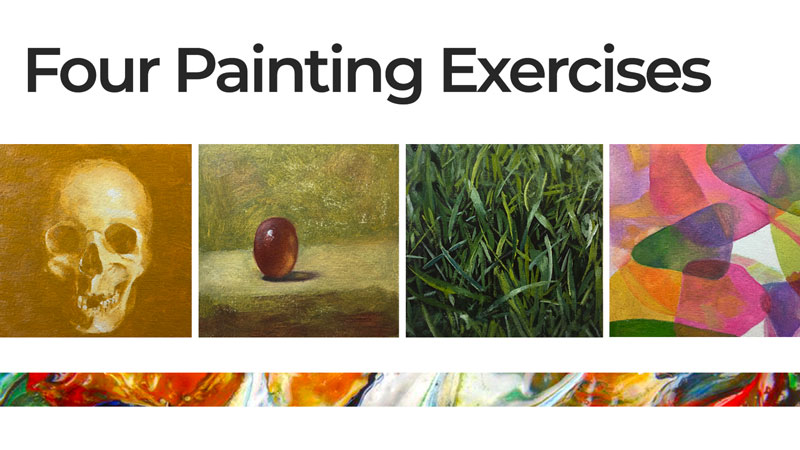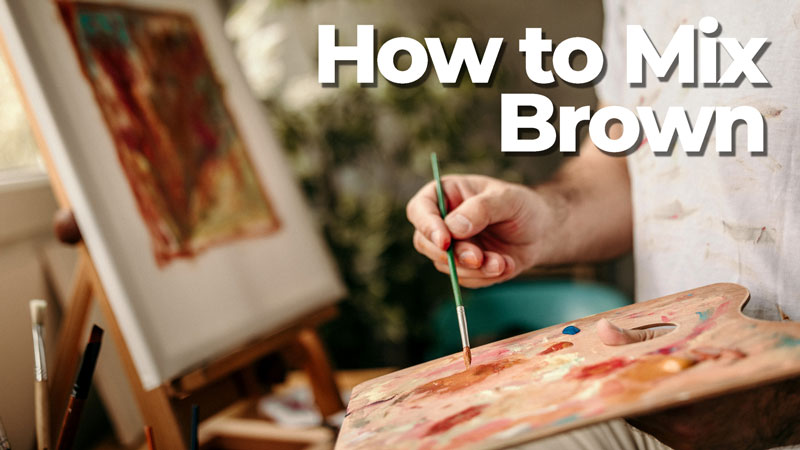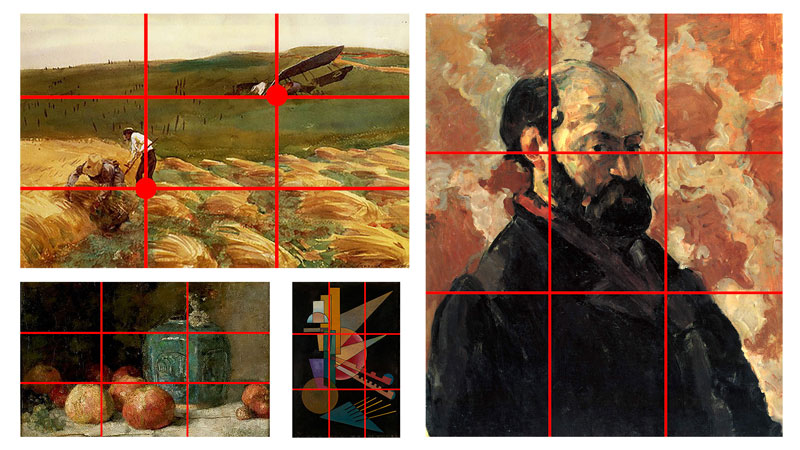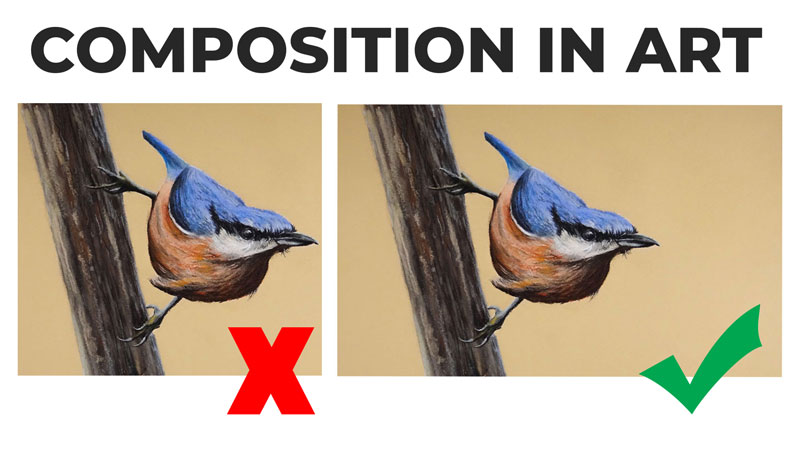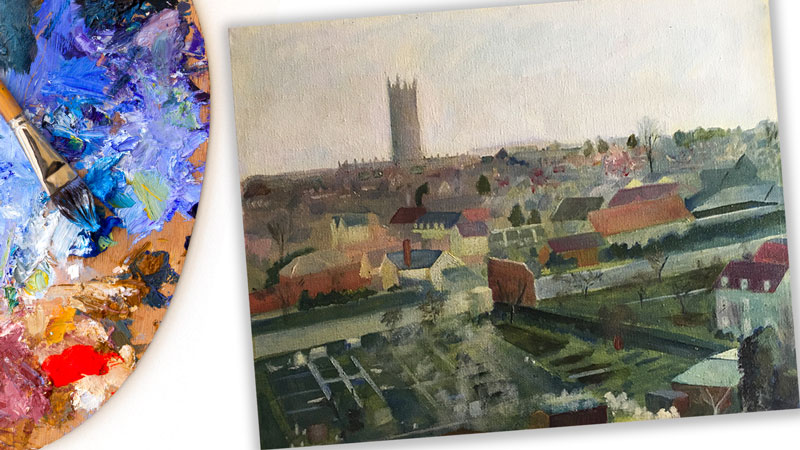
So many decisions. All a person can do is try the many different approaches to painting to see what works for them.
One technique all painters should try at some point is wet into wet. That is, intentionally mixing all colors on the canvas and none on a palette – essentially using the canvas as a palette.
Painting wet into wet has several benefits – speed, economy, variety and painterliness (yes, it is a word).
It’s important to note that while this technique can be used with any painting medium, it works best with paints that dry slowly. Oils are obviously a great choice, but acrylics can also be used if a slow drying medium or “Open” acrylics are utilized.
Now, let’s look at a few reasons why “wet into wet” may be attractive option for the artist.
Speed
First, art is not a sport but it can be a race. When a window or the sun is the primary light source, then painting is a race against time. Colors and values must be captured before the light has a chance to change and it changes faster than one might imagine. Wet into wet painting saves time. Instead of starting a painting session by mixing colors on a palette, one begins by immediately applying paint to the canvas, thus saving a step.
Speeding up the painting process gives us a better chance of capturing the fleeting effects of light across a form as we see it in the moment.
Even when a painter uses artificial light or photographs, speeding up the painting process is still advantageous.
Economy
A small palette is easy to carry and, when painting wet into wet, a small palette will do since no space is required to mix colors. That’s good news for those that paint outdoors or on location. Doing so can make an artist feel like a pack-mule sometimes. Paints, solvents, and canvases are already cumbersome enough to carry without a big, heavy palette.
If one is mixing on the canvas, then even a disposable plate is large enough to use and weighs next to nothing.
Variety
Perhaps the greatest benefit to wet into wet painting is variety. Variety is one of the principles of art and a recurring theme found in nature.
When mixing on a palette, colors are usually mixed thoroughly and completely. Mixing on a canvas adds variety by default because one is trying to mix colors while also creating and maintaining contours. Colors are sometimes less thoroughly mixed near the edges of those contours when mixed on the canvas. The results, intentional or otherwise, are areas of only partially mixed color, thus creating variety.
Furthermore, when mixing on a canvas, one typically uses a brush instead of a palette knife. The motion of mixing paint with a brush also adds a variety of strokes to a painting’s surface texture. This creates a feeling of energy and vigor when compared to a typical “mix-on-a-palette painting” which usually appears more controlled.
Painterliness
Many artists do not need help “loosening up” and still other artists work in a tight, hard-edged fashion by choice. However, for artist that wants to loosen up but struggles to do so, then painting wet into wet can be a breakthrough technique. In the spirit of wet into wet painting, one may also try to begin painting without a preliminary drawing.
A well defined drawing can unfortunately encourage the “coloring book effect”. That is, the inclination to simply fill in shapes with solid, homogenous colors and prevent these colors from mingling in any way. This is not how color and light works.
See also: Expressive Brushstrokes with Acrylics
Color and light bounce around a bit. If you place something green next to an object of another color, the green color is likely to reflect into the second object.
Look at the images below. See how the color of the paper reflects back into the plaster hands. This effect has a better chance to happen incidentally when painting without an under drawing while using a wet into wet approach. This mingling of color actually feels more realistic and atmospheric.
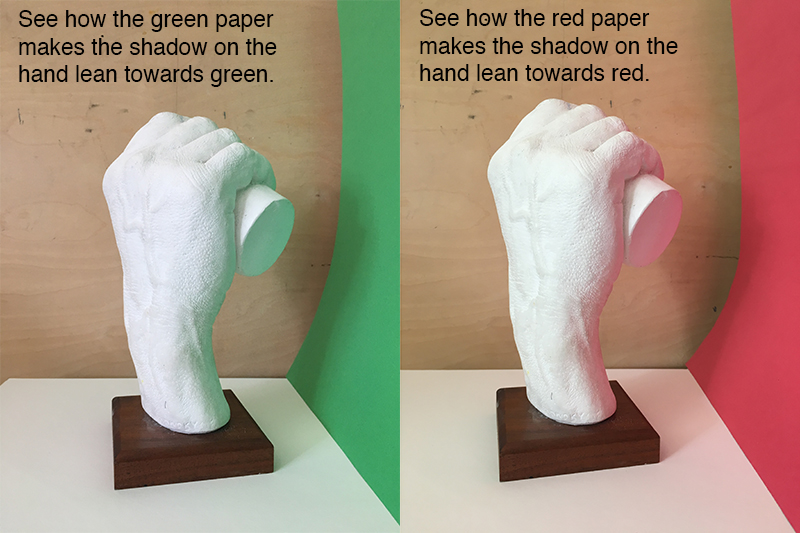
Painting Wet Into Wet
The following images and commentary chronicle the development of a wet into wet painting alongside the palette used for the art. The painting is based on the reference image directly below.
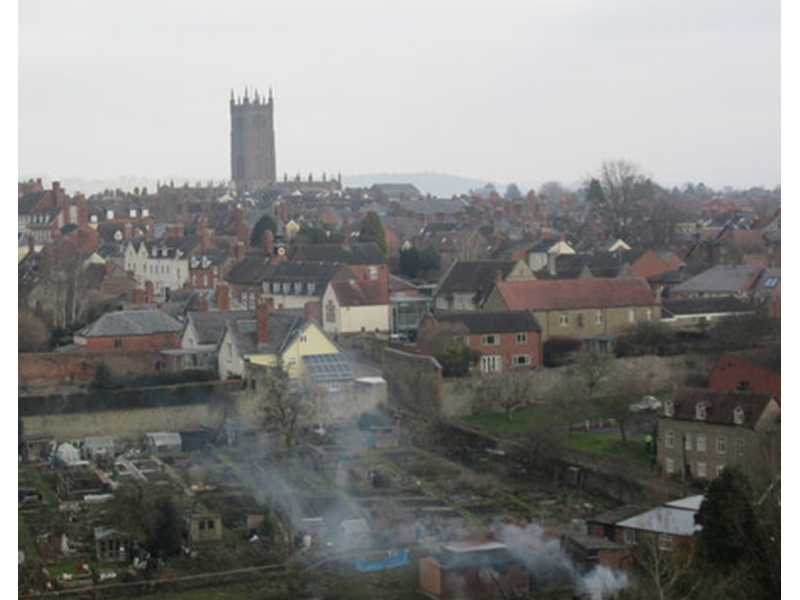
The following image shows a palette and also a first few minutes of painting. The colors on the palette are listed clockwise:
- Titanium White
- Ultramarine Blue
- Cadmium Yellow
- Alizarin Crimson
- Cerulean Blue
Additionally, a standard painting medium (50% linseed oil/50% solvent) is used thin the paint. The medium thins the paint making it easier to spread. It will also be used to make glazes, later in the painting process.
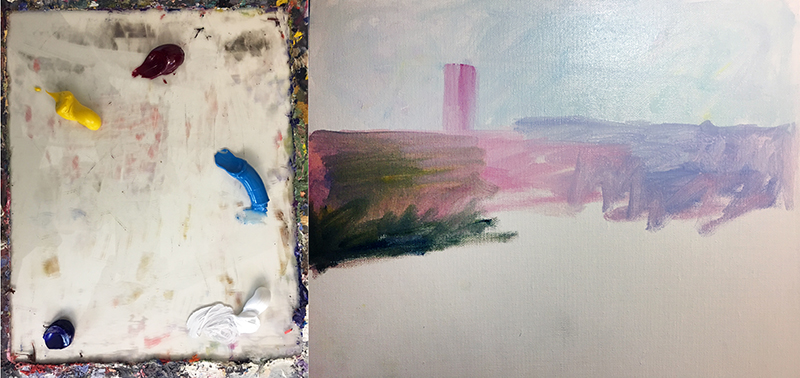
The first pigment applied to the sky was white since the sky is so light in value. At this stage, the palette looks unused even though half of the painting is already covered in color.
Now, see how bright the painting looks in the next step (below). The intense blue diagonal line will become a dark brown wall eventually.
A brick wall on the left of the reference image is, at present, just a bright red stripe. The house in the foreground currently has a purple roof.
Each additional color mixed into these areas will dull these colors. Of course, the goal is not exact color matching, but rather a harmonious final product.
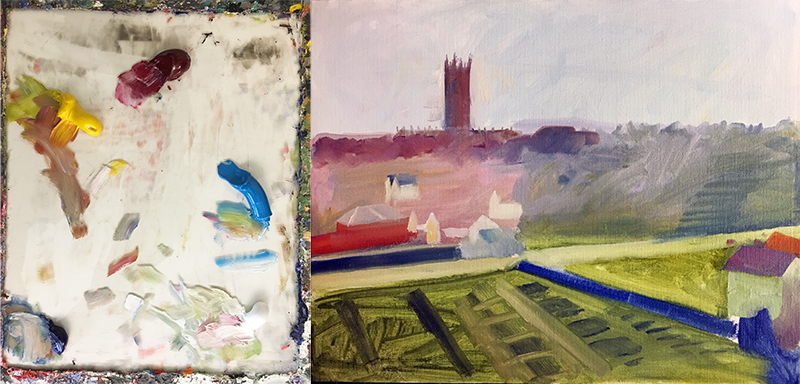
Once a wet into wet painting is “blocked-in”, it truly becomes a palette.
There are color mixtures all over the surface from which the artist may borrow. Look at the small light marks just below the horizon. Those marks are too small to mix from the primary colors on the actual palette. Instead, color was lifted from the lighter colored houses in the middle ground and redeposited in the background. When a single color is used in various locations throughout a composition, it contributes to the oneness or unity in a composition.
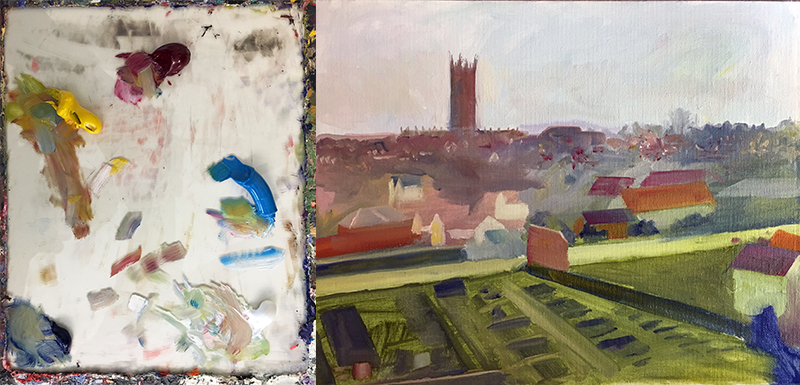
It is now time to develop the foreground. The additional buildings in the bottom right (see below) help to balance the tall tower in the top left quadrant of the composition. Also in the bottom right, adding a little yellow will transform that bright blue spot into a tree. The blue will mix with the yellow producing a natural green.
At this point the palette looks a little “messy” but no intentional mixing has taken place. Notice the light blue area in the top right corner of the palette. That is not a mixture of blue and white. It is a pure, ultramarine blue glaze. It appears light simply because the white palette is showing through.
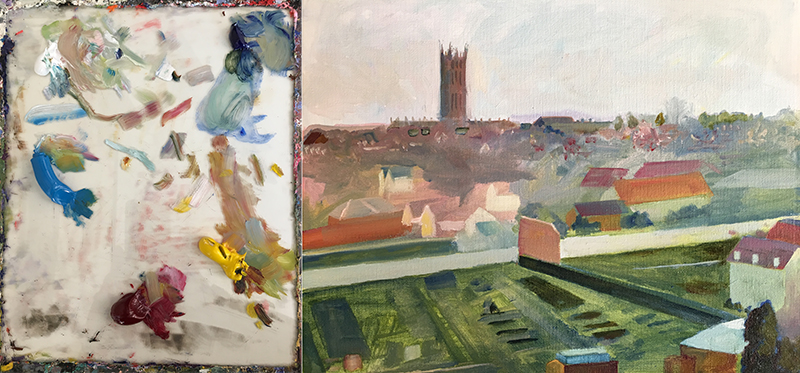
Glazing
Glazing is a technique in which paint is heavily thinned out with painting medium to the point of transparency. Applying a glaze over colors that have already dried will slightly alter those colors underneath. Glazes can be used for color correction and adding depth and complexity to the color.
Do not attempt to apply a glaze over wet paint. This painting was completed during three short painting sessions. Only after allowing some areas to dry was it possible to do any glazing.
See also: Glazing with Acrylics
Additional trees are painted among the house in the next step. The dark green color was borrowed from the large tree in the lower left. Some darker rooftops were added as well.
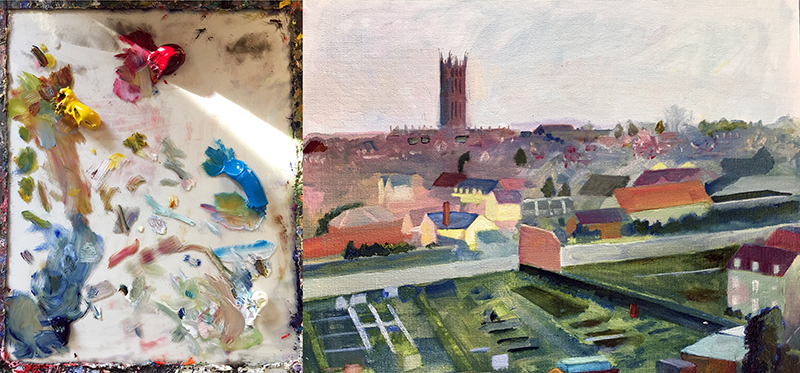
Scumbling
At this point the painting is entering its final stages. It is allowed to dry, then the sky and tower are scumbled.
Scumbling is another painting technique that does not require mixing on the palette. Scumbling is the process of applying opaque color that is usually applied without any medium. Typically the strokes are broken, allowing some of the color underneath to show through.
Scumbling can be used to apply any color, but in this case, only a small amount of pure white is used. It is scrubbed out vigorously to create a translucent film, slightly lightening the dried color under it. In this case, it was done to add atmosphere to the painting, lightening and weakening the color of the tower in the distance. This sense of atmosphere was clearly missing when compared to the reference image.
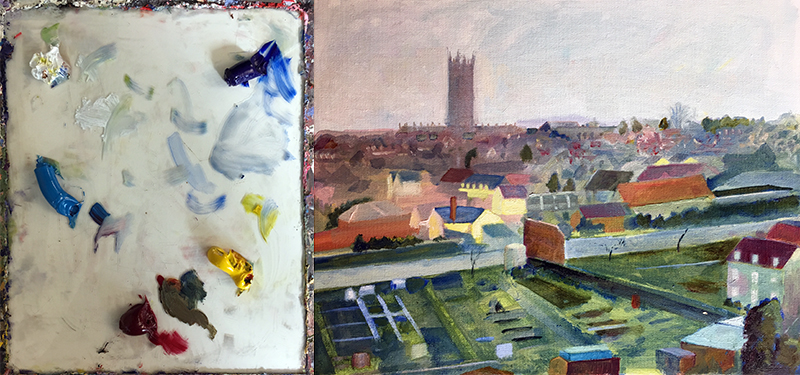
After scumbling with white, a few small trees are added as well as the smoke in the foreground as observed in the reference photo.
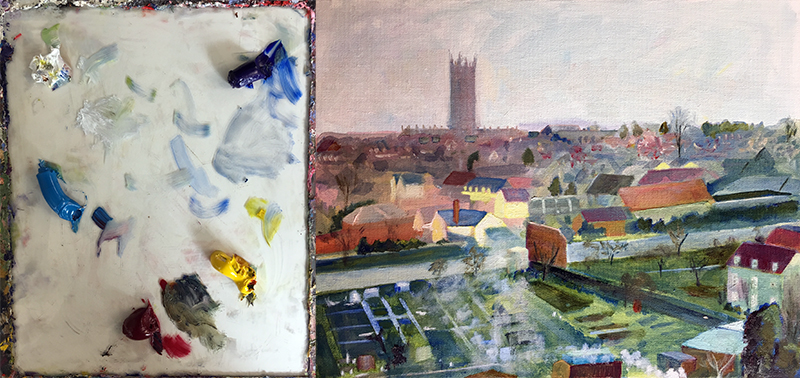
Again, the painting is allowed to dry. Then, to further dull colors and also to enhance the unity of the painting, a glaze of yellow was applied to the entire canvas.

Conclusion
Wet into wet is a wonderful painting technique that is sure to loosen up your paintings – making them more lively, unified, and interesting. While a palette is the traditional place for mixing colors, the canvas is also a location where this can happen.
Scumbling and glazing are techniques not usually associated with wet into wet painting since they are used over dried paint. However, they share a commonality with the wet into wet technique. While wet into wet is used to make physical mixtures on the canvas, scumbling and glazing create optical mixtures on the canvas. All three techniques are used to alter color directly on the canvas requiring very little palette space.
Try these methods yourself and find out what works for you.
If so, join over 36,000 others that receive our newsletter with new drawing and painting lessons. Plus, check out three of our course videos and ebooks for free.


